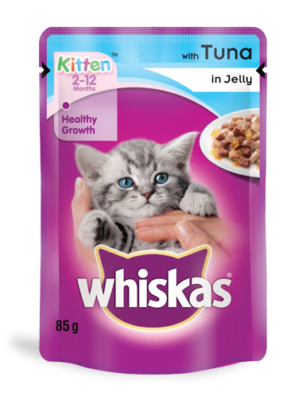In the wild, big cats know exactly what they need to eat. By feeding your kitten the right food at the right times, you’ll be supporting their natural instincts as a carnivore and solitary hunter.
Special kitten food
For the first four to five weeks of their lives, your kittens will get all they need from their mother. They are normally weaned-off by seven weeks, but from week four they can already begin eating specially prepared kitten food such as Whiskas Kitten Meat in gravy or jelly.
Small tummy, big appetite
Those cute little kitties might be small, but they will grow 15 times faster than a human baby! With stomachs that start out as the size of your thumbnail, they can’t eat very much in one go. That’s why it’s important to feed kitten’s small meals at regular intervals, up to six times a day to begin with. In the early days, try spreading the food onto a plate so your kitten can just lick and get a taste for it.
Kitten to cat portions
Whiskas Kitten Pouches are perfect for a single tasty meal for kittens between two and 12 months. They should be fed three to four meals a day until they are six months old. Following this, they can be fed between two and four meals a day. Kittens can eat Whiskas Adult Pouches twice a day when they are between 10 and 12 months old.
Careful eaters
In the wild, big cats are careful eaters, avoiding anything that tastes “off”. Kittens share those instincts and will prefer every meal to be fresh, served at room temperature and in clean bowls.



Not on the menu
After kittens are weaned, they lose their ability to digest milk – so no cow’s milk for them! Many human foods can be harmful to cats, for example, onions can cause anaemia. So, don’t be tempted to give her table scraps and human treats. If you feed your cats the right food at the right times, they’ll be getting all the nutrition they need.
Sensitive to taste
Kittens’ tongues are highly sensitive to both temperature and taste. Just like their big cat cousins, they’ll protect themselves by avoiding stagnant water or anything that doesn’t taste fresh. That’s why kittens may prefer to drink from a puddle in the garden – they can taste the harmful chemicals we use to keep tap water clean.
Litter tray
In the wild, big cats are careful about keeping clean. That’s why they don’t eat and go to the toilet in the same place. Kittens are no different, so make sure you keep the litter tray well away from the places where they eat and drink.
A long and healthy life
A shiny coat, bright eyes and supple muscle tone are all good signs your kittens are nutritionally healthy. If you feed them a balanced diet that’s right for every stage of their lives, you’ll soon see it reflected in their appearance.
As your little feline friends approach their first birthdays, they’ll be ready to move on to eating a balanced adult diet that is suitable for their growing needs. Your kittens are highly sensitive to changes in taste and temperature, as well as any change in diet, so make sure you gently ease them into their new diet.
To find out more about Whiskas product availability that is best for the newest edition to your family, visit us on the Whiskas Website or Facebook page.


